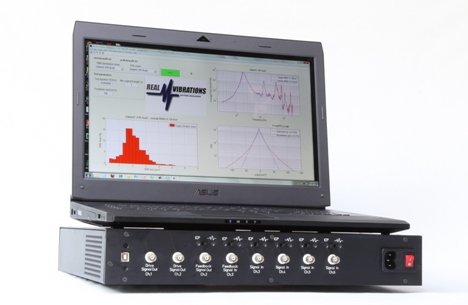Controllers
Our suite of vibration shaker controllers are designed for engineers by engineers and are built to be used intuitively for a broad range of applications. Our software applications use sophisticated and robust signal processing and control algorithms to achieve the best possible results for various types of vibration tests systems. Some of the features of our controllers are:
- Speed and accuracy. 16 bit accuracy (96 dB dynamic range) and up to 16,000 spectral lines at up to 2 MSamples/s aggregate (hardware dependant) with a control bandwidth of up to 20 kHz.
- Ease-of-use. Our software is designed to be used intuitively. It contains on-line help and guidance throughout and our website includes videos dedicated to guiding users through the features and functions of our system.
- Adaptability. Can be used for new vibration test systems of all kinds including those with servo-hydraulic, electrodynamic and electric actuators or can be retrofitted onto existing vibration tests systems. Click here for important information on shaker system characteristics and performance.
Random Vibration Controller (Single and Multi-axis)

Our Random Vibration Controller (RVC) is a state-of-the art instrument for recreating and controlling random vibrations in a laboratory setting for user-defined or standard test protocols (ASTM, ISTA, ISO and Mil. Std.). The RVC can be configured to control up to four axes (degrees-of-freedom) simultaneously in multi-axis systems such as Heave, Pitch and Roll. Follow these links to see video demonstration of the single axis and multi-axis RVCs. Optional add-on modules available for the RVC include:
- NonStationary Random Vibration. Enables the simulation and of nonstationary (high kurtosis) random vibrations by random fluctuation of rms vibration levels. This technique, unique to Real Vibrations, is used to simulate more realistic transport vibrations by stochastically varying the rms level of the synthesized random vibrations in accordance to a statistical distribution. A video demonstration of the Statistical Vibration Synthesizer can be found here.
- Gap-free data capture. Continuous streaming-to-disk of up to 31 channels with data stored in Matlab® format.
- Shock-on-Random. Transients in the form of half-sine shocks can be superimposed at regular intervals onto the background random signal. The amplitude, duration and shape of the shocks can be defined by the user as well as the interval at which the shocks are repeated. A video demonstration of the Shock-on-Random module can be found here.
- Sine-on-Random. Allows the user to superimpose any number of sinusoids of pre-determined amplitudes, frequencies and phase angles, onto the background random vibrations. A video demonstration of the Sine-on-Random module can be found here.
- Swept-sine-on-Random. Enables the user to superimpose a number of swept-sine waveforms on the background random vibrations. The frequency band and amplitude of each sinusoid is fully configurable. In addition, the number of sweep cycles and the sweep method (logarithmic or linear) can be controlled. A video demonstration of the Swept-sine-on-Random module can be found here.
- Field Data Analyser. Enables the analysis of random vibrations based on measured field data. Native SXd multi-channel data data recorded with Saver® can be processed to calculate the overall Power Density Spectrum (PDS), 3D frequency periodograms, RMS distribution as well as RMS and crest factor time histories. Some features of the Field Data Analyser are: data integration, differentiation and re-scaling tools; GPS event location viewing in GoogleEarth™; Optional configuration for uploading data from other third party instruments such as innRecord®, IST®, SlamStick®, enDaq® (can be implemented upon special request). A video demonstration of the Field Data Analyser can be found here.
Transient Replicator Module
The Real Vibrations Transient Replicator (TR) module is designed to generate multiple classical shocks (half-sine, trapezoidal, saw tooth) or arbitrary transients defined or measured by the user. Target signals can be saved in ASCII txt format from a variety of standard software applications. Adaptive filter algorithms are used to optimize replication accuracy. Replicated data (as measured with the feedback accelerometer) can be exported in txt format for further analysis. Optional additional data capture from up to 31 auxiliary channels are available. A video demonstration video of the Transient Replicator can be found here. The Transient Replicator is only applicable to one DoF with acceleration feedback.
Signal Replicator Module
The Real Vibrations Signal (vibration) Replicator module enables the reproduction of any vibration signal of any duration measured with a Saver® instrument by Lansmont®. Options for importing and replicating data in different formats from other instruments can be made available on demand. Alternatively, target replication signals can be created or configured with any third party software application and saved in txt format. The module includes software for applying configurable digital filters to the signal and well as a propriety facility for automatically correcting the target replication signal such to avoid exceeding the shaker displacement limits. The replicated vibrations can be stored to disk as a binary (.dat) file that can be accessed with many common software applications. Optional continuous data capture of up to 31 auxiliary channels is available. A video demonstration video of the Signal Replicator can be found here. The Signal Replicator is only applicable to one DoF with acceleration feedback.
Sine and Swept-sine Controller
The Real Vibrations Sine and Swept-sine Controller generates and controls fixed frequency sinusoids for resonance dwell and fatigue type tests as well as swept-sine vibrations for resonance search and durability and endurance testing. Optional continuous data capture of up to 31 auxiliary channels is available. A video demonstration video of the Sine and Swept-sine Controller can be found here. The Sine and Swept-sine controller is only applicable to one DoF with acceleration feedback.
Seismic Motion Controller
Our Seismic Motion Shaker Controller is a state-of-the art instrument for recreating and controlling multi-axis seismic motion in a laboratory setting for earthquake testing. The system is designed to simulate and control (time-history replication) of numerous seismic test waveforms such as VERTQII (zones 1 -4) as well as any measured or user-created transient waveforms. The Shock/Test Response Spectrum (SRS or TRS) is automatically calculated and compared with the relevant Test Response Spectra (TRS) such as those specified by Telcordia (Bellcore) GR-63-CORE NEBS. Here is a link to a demonstration video of the Seismic Motion Controller.
Our single and multi-axis controllers can be adapted and configured for a variety of dynamic motion control applications such as:
- Water wave generator controller with pre-configured wave spectra and wave probe feedback + real-time data capture on up to 31 auxiliary channels.
- Multi-post road simulators with pre-configured road profile functions, road surface aberration simulation (shock-on-random), varying road roughness simulation, displacement or acceleration feedback.
